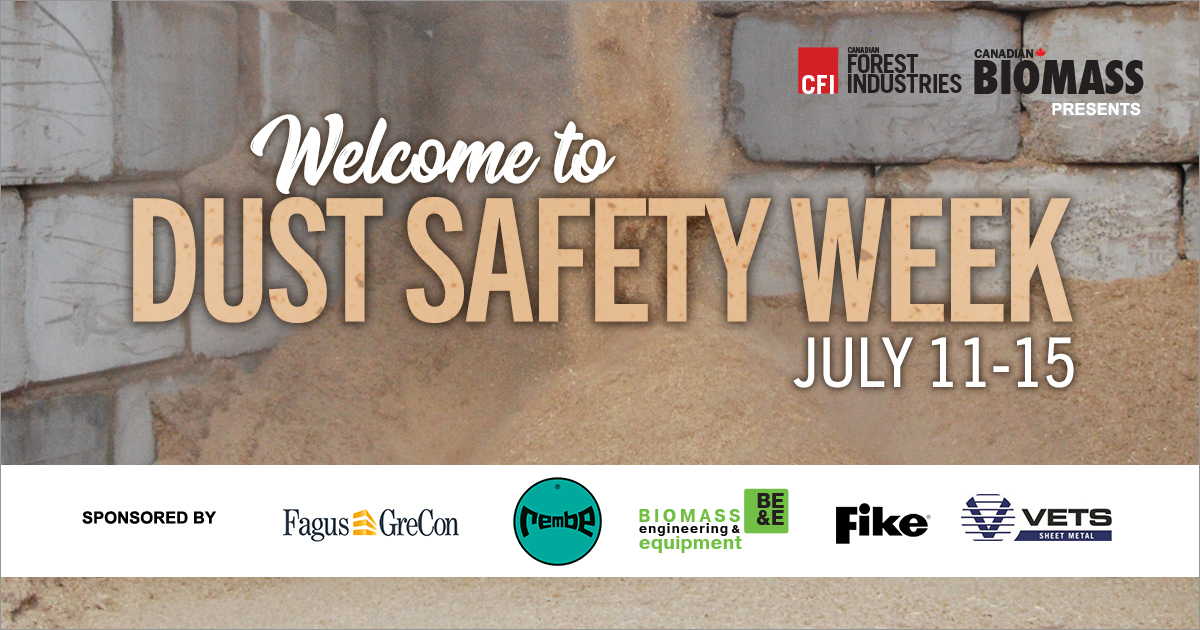
This year was the 10th anniversary of the two B.C. sawmill explosions that killed four people and injured many others.
WorkSafeBC’s investigation for both incidents pointed to a combination of the concentration of dispersed wood dust in the air and friction from moving equipment. Ineffective dust control measures and maintenance oversight were found at both sites.
It’s an important reminder that complacency can be fatal, especially in industries that process a combustible material.
For the sixth year in a row, Canadian Biomass and Canadian Forest Industries turned the spotlight on dust with our annual Dust Safety Week. Over the past five days, we’ve shared on our website and social channels (#DustSafetyWeek) new and archived content from our partners to highlight best practices when it comes to dust management in wood processing facilities.
Here’s a snapshot of what we learned during the week:
1) Don’t wait for an incident: WorkSafeBC’s Alexandra Skinner wrote about the importance of reviewing dust management programs regularly. She quotes WorkSafeBC prevention field services manager Budd Phillips, who says the pandemic likely drew away resources from proper maintenance and evaluation of those programs. Now, he says, is the time to revamp dust management programs to reflect evolving operational needs.
2) Need to vent? Talk to an expert: Biomass Engineering & Equipment’s Joel E. Dulin shared practical advice on conveyor explosion venting, specifically diving into the questions about whether to choose active or passive mitigation methods or whether or not you can mitigate explosion risks without expert assistance.
3) Fire prevention strategies: Tom Burniston with Fagus GreCon wrote an overview of field-proven automated fire prevention solutions to help protect people, premises and enable uninterrupted process and production in the wood pellet industry.
4) Lessons from the past: DustEx Research’s Rose Keefe shared the story of the Murray Grain Elevator explosion. “… the events that led up to the disaster continue to replicate themselves today, and not just in the grain handling industry. Every year several people are injured and even killed in explosions at sawmills, pellet production plants, and woodworking facilities, and if lessons aren’t learned, more lives and livelihoods are likely to be lost,” she wrote.
5) Deciphering the dust hazards analysis: Jeramy Slaunwhite, a senior explosion safety engineer with Rembe, explained the what, when, why, where and how of dust hazards analysis in facilities that deal with combustible particulate.
6) Stop high-pressure compressed air dust cleaning: John Bachynski with EPM Consulting has a cautionary message for wood processing facilities: stop using high-pressure compressed air to cleanup your mill. Bachynski explains why compressed air blowdowns are the easiest way to blowup your wood manufacturing facility.
Today is the final day of Dust Safety Week 2022, and we’ll continue to share archived content from years past, which hold just as much relevance today. And don’t forget about the Wood Pellet Association of Canada’s webinar on deflagration isolation, happening Monday, July 18.
Dust safety should be top of mind year-round. That’s why our landing page (find it here – or in our top menu, under Information) is continually updated throughout the year with relevant lessons learned, solutions, and technical information to keep facilities and operators safe.
And I’d like to once again thank this year’s Dust Safety Week sponsors for making it all possible: Biomass Engineering & Equipment, Fike, VETS Group, Fagus GreCon and Rembe.
Print this page
